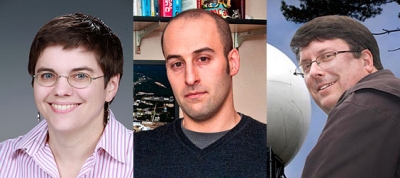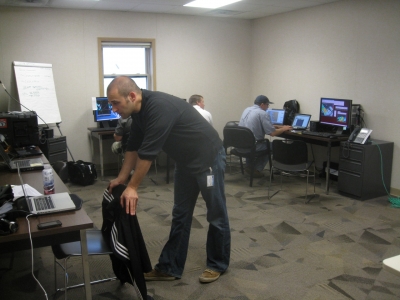ARM Translators taking on new challenges: Mike Jensen steps down, Laura Riihimaki and Scott Giangrande step up
The role of lead translator is changing hands as Laura Riihimaki, Pacific Northwest National Laboratory (PNNL), takes over for Mike Jensen, Brookhaven National Laboratory (BNL). Scott Giangrande, BNL, is also joining the translator team.

Speaking the Language of Data
Translators are an essential part of the ARM infrastructure. They help make sense of the massive amounts of data being collected by instruments—in 2015, an average of almost 430 gigabytes was collected every day. A comparable amount of data in high quality movies would take 18 days to watch.
To help sort through all the information, translators work with ARM infrastructure staff and the user community to identify and apply scientific algorithms to the data to make it more useful for the scientific community. ARM uses the term “translators” because these scientists “translate” the needs of the ARM user community into data products. They manage the development of value-added products, or VAPs, which process and analyze instrument data in support of science goals. VAPs are a key component of turning the signals actually measured by the instruments into the geophysical quantities (e.g., cloud base height, aerosol optical depth, or liquid water content) of interest to scientists. VAPs may also combine multiple instruments to determine a ‘best estimate’ value or to better constrain a geophysical quantity.
Every higher-level data product has a translator who knows its ins and outs. ARM users are encouraged to reach out to translators if they have any questions regarding specific data products or ideas for new data products.
Passing the Torch
Mike Jensen, meteorologist at BNL, is stepping down after 11 years on the translator team. He began as a translator for what was the ARM Cloud Properties working group, and in 2009, took over as lead translator from Jennifer Comstock.
In his role as lead translator, Jensen coordinated with both developers—ARM infrastructure staff who write the code for VAPs—and scientists to improve data product development. He said his biggest accomplishments were formalizing data product development procedures and taking Active Remote Sensing of Clouds (ARSCL) VAP from a “very hands-on, labor-intensive VAP to one that requires very little intervention and runs operationally.” Jensen’s legacy also includes superb operational leadership, or as Laura Riihimaki put it, “making sure things always ran smoothly.”

Riihimaki, atmospheric scientist at PNNL, will be taking over for Jensen after four years as a translator. She’s excited to continue building on the work he’s done and is always looking for ways to improve. “One of her most important qualities is her enthusiasm for making ARM the best facility possible,” Jensen said. “She’ll make a great lead translator.”
Joining the translator team is Scott Giangrande, meteorologist at BNL. He has extensive past experience in radar observation of clouds and precipitation and has already been working closely with the ARM development team at BNL in his six years there.
# # #
The ARM Climate Research Facility is a national scientific user facility funded through the U.S. Department of Energy’s Office of Science. The ARM Facility is operated by nine Department of Energy national laboratories, including Brookhaven National Laboratory and Pacific Northwest National Laboratory.

